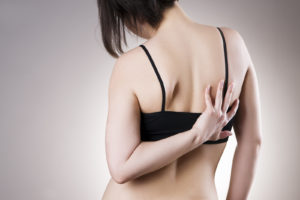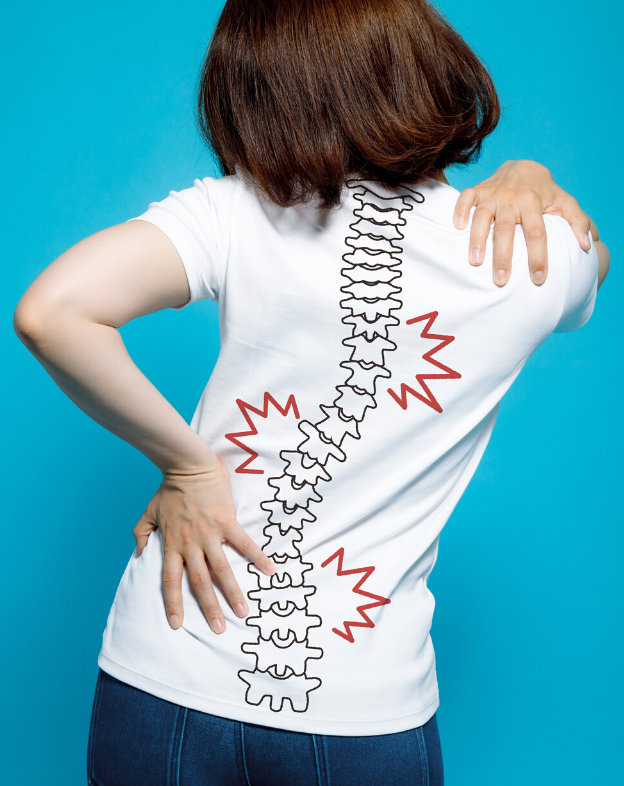Scoliosis pain is the number one complaint when adults present to our office seeking help. When it comes to scoliosis, pain doesn’t discriminate in regard to Cobb angle, since curves need not be severe for patients to experience pain. However, having scoliosis doesn’t have to mean you are destined for a lifetime of discomfort. Our patients learn conservative techniques and tools to overcome pain, stop progression, and improve quality of life.
The good news is that long-term follow-up studies of adolescent idiopathic scoliosis populations show that the expectation is for a long, healthy life, albeit with slightly more back pain than the general population (1). Pain (no matter when scoliosis is diagnosed) is usually caused by spinal degeneration. Degeneration is the result of accelerated aging of the spine due to uneven wear and tear. The bad news is that the scoliosis patient is more vulnerable to advanced degeneration because of the asymmetric configuration of the spine.
That doesn’t mean you should lose hope if you have scoliosis pain. The techniques we use at Scoliosis 3DC® are designed to help patients manage pain, or preferably alleviate it! Before we get into that, let’s take a closer look at some scenarios when pain develops. A skilled practitioner can determine the cause of pain from a medical history, physical examination and x-ray.
Some adults with scoliosis present with spinal stenosis. Stenosis is a narrowing of the spinal canal where the nerve rests. The spinal canal narrows on the side of the concavity due to the asymmetric spinal configuration of scoliosis. This causes nerve impingement/compression. Stenosis typically occurs in the lower back, but not always. Common presentations include localized low back pain and/or referred pain down the leg. Patients often experience pain or discomfort when attempting to stand up straight. Leaning forward usually alleviates the pain. Having scoliosis surgery as an adolescent doesn’t mean a patient isn’t at risk for spinal stenosis because scarring from back surgery may develop and result in pressure on the spinal nerves later in life.
Degeneration of the facet joints (posterior joints of the vertebrae) is another potential cause of pain. When there is facet joint involvement, the patient often presents with low back pain but may also have referred pain. Bending backward usually aggravates the pain. People commonly refer to this as osteoarthritis.
Disc herniations are another cause of pain with scoliosis. Herniations typically occur on the side of the convexity. This is because the open-wedged side of the disc and continued asymmetric pressure can cause the disc fibers to tear over time.
Spondylolisthesis – slippage of one vertebra on top of the other – is another cause of pain. Anterolisthesis is the term for forward slippage, and retrolisthesis is a slippage backward. Spondylolisthesis is graded on a scale of 1 – 4 based on how much slippage is present. The condition causes severe low back pain and is worse with exercise or extension of the lumbar spine. Patients sometimes report back stiffness or have a limited range of motion and tight hamstrings. A spondylolisthesis can lead to degenerative scoliosis.
Lateral listhesis is a lateral (sideways) slippage of one vertebra on top of another typically accompanied by rotation (twisting). This is most commonly found in the lumbar spine, usually the L3/L4 area, and also extremely painful. With this condition, it is common for patients to present with weakness of the connective tissue surrounding the area of pain. Of patients with scoliosis, 44% are said to develop a lateral listhesis at some point (2).

Traditional Ways of Treating Scoliosis Pain in Adults

Orthopedic doctors admit to treating back pain for patients with scoliosis the same way they treat back pain in the general population (3). In general, doctors recommend that patients with back pain do core strengthening exercises (some of which are not ideal for the scoliotic), take pain medication, have spinal injections, or perhaps surgery. At Scoliosis 3DC®, we approach things differently!
General exercise recommendations for patients with scoliosis often fail. Often patients think they are doing something good for themselves but this is where trouble can develop. We’ve seen patients whose pain has gotten worse as a result of exercise. This is because general exercises for scoliosis don’t take the spinal curve pattern into account. As an example, some doctors recommend (or patients mistakenly think) that yoga for scoliosis is a good route to take. However, with yoga, scoliosis patients must be extremely careful not to exacerbate their spinal imbalances. With yoga, everything is bilateral and symmetrical, but the spine of a person with scoliosis is not! If you want to read more on this topic, read our blog on yoga and scoliosis.
Another suggestion is often pain/anti-inflammatory medication. We’re pretty sure that most people would prefer not to get accustomed to taking medication for their scoliosis pain regularly. This can lead to other health issues, such as GI problems, or worse yet, possible addiction.
Epidural steroid injections around the spinal cord and nerve roots sometimes help. However, injections tend to lose their effectiveness over time, and/or don’t have lasting effects for some people. Most doctors don’t/won’t recommend a series of repeated injections due to safety concerns.
Surgery for scoliosis pain is usually a last resort. It’s probably safe to say that most people would rather not have surgery. Aside from that, in terms of outcomes, scoliosis surgery for adults doesn’t have the best track record. According to one systematic review on adult scoliosis surgery, “Perioperative morbidity includes an approximately 13% risk of pseudarthrosis (arthritis as a result of hardware implantation) and a greater than 40% incidence of perioperative adverse events.” (4).
Effective, Conservative Treatment for Scoliosis Pain
At Scoliosis 3DC®, our way of approaching pain differs from the traditional approaches. We treat according to curve-pattern and cause. Since the inciting cause of scoliosis pain is usually spinal degeneration, the key to our program is learning how to “unload” the spine to reduce the pain. We accomplish this via pattern-specific scoliosis rehabilitation (PSSR) exercises and activities of daily living instruction. Scoliosis-specific exercises take spinal asymmetries and resulting spinal imbalances into account. An unbalanced spine and trunk means that the muscles on the concave side of the spine are shortened, and the muscles on the convex side are lengthened. We help patients learn how to improve spinal balance.
Patients learn to integrate the postural modifications and exercises to counteract scoliosis pain. This can help prevent further deterioration and stop or slow the rate of spinal degeneration. Learning skills to help manage scoliosis as early as possible is best, but it’s rarely too late. The biggest contraindication for our treatment program is osteoporosis. Once we learn about your history we will let you know if you are a candidate for care.
When patients understand their curve pattern and what to do and what NOT to do, it makes a difference. Our experienced team, led by Dr. Marc (he’s been involved with Schroth since 2002!) create custom programs and instruct patients one-on-one (no group classes!). Learn more here about our adult treatment programs. Programs are typically 12 or 17 hours of intensive instruction over a few days (for out-of-area patients). However, for those in extreme pain (or for local patients), instruction can be extended over a longer period. Many of our adult patients have achieved pain relief in only a few days! Some adult patients also opt for a scoliosis brace.
Scoliosis rehabilitation and bracing are both done at our Massachusetts location. Aside from convenience and efficiency, if you participate in our scoliosis rehabilitation program, your brace is fitted by practitioners who truly understands the nuances of your spine and curve-pattern.
Why do some adults scoliosis opt for a scoliosis brace? Many adults report that it’s tiresome to assume an upright posture as the day goes on. Our brace is for adults who experience fatigue, discomfort, pain, and/or collapse. This usually occurs at the convex side of the curve and is due to having to constantly fight gravity to stand upright, again, due to the spinal imbalances that come with having scoliosis. Bracing for adults attempts to alleviate pain and provide spinal support. This is done by resetting the spine toward the midline to help reduce pressure on the joints and muscles. Nearly all adults who we’ve fitted with braces in the past tell us how much they appreciate having the brace! Adult bracing for scoliosis is on an as-needed, part-time basis. You decide how little or how often you want to wear it.
1) Weinstein SL, Dolan LA, Spratt KF, Peterson KK, Spoonamore MJ, Ponseti IV. Health and Function of Patients With Untreated Idiopathic ScoliosisA 50-Year Natural History Study. JAMA. 2003;289(5):559–567.
2) Kilshaw M, Baker RP, Gardner R, Charosky S, Harding I. Abnormalities of the lumbar spine in the coronal plane on plain abdominal radiographs. Eur Spine J. 2011 Mar; 20(3):429-33.
3) https://health.clevelandclinic.org/5-surprising-facts-about-adult-scoliosis/
4) Yadla S, Maltenfort MG, Ratliff JK, Harrop JS. Adult scoliosis surgery outcomes: a systematic review. Neurosurg Focus. 2010 Mar;28(3):E3.

